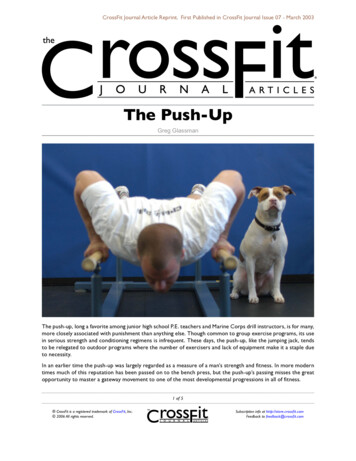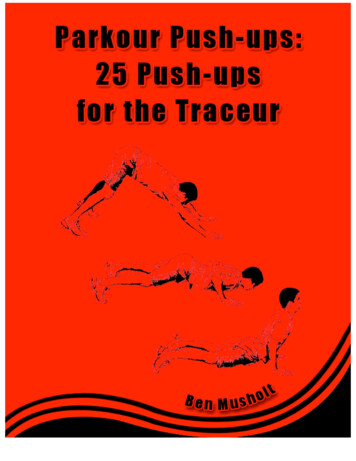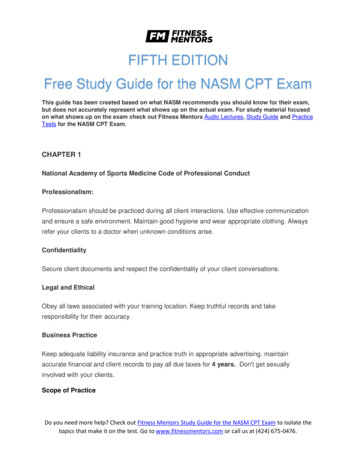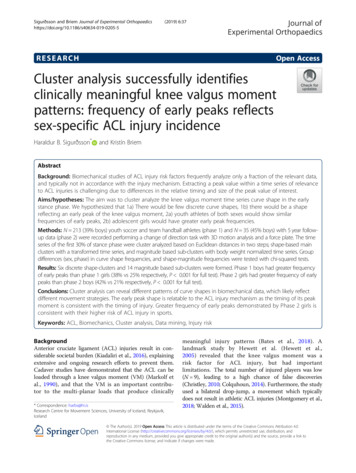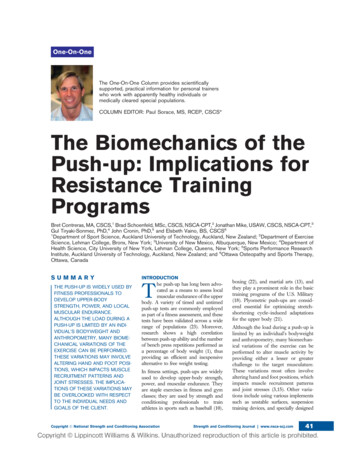
Transcription
One-On-OneThe One-On-One Column provides scientificallysupported, practical information for personal trainerswho work with apparently healthy individuals ormedically cleared special populations.COLUMN EDITOR: Paul Sorace, MS, RCEP, CSCS*The Biomechanics of thePush-up: Implications forResistance TrainingProgramsBret Contreras, MA, CSCS,1 Brad Schoenfeld, MSc, CSCS, NSCA-CPT,2 Jonathan Mike, USAW, CSCS, NSCA-CPT,3Gul Tiryaki-Sonmez, PhD,4 John Cronin, PhD,5 and Elsbeth Vaino, BS, CSCS61Department of Sport Science, Auckland University of Technology, Auckland, New Zealand; 2Department of ExerciseScience, Lehman College, Bronx, New York; 3University of New Mexico, Albuquerque, New Mexico; 4Department ofHealth Science, City University of New York, Lehman College, Queens, New York; 5Sports Performance ResearchInstitute, Auckland University of Technology, Auckland, New Zealand; and 6Ottawa Osteopathy and Sports Therapy,Ottawa, CanadaSUMMARYTHE PUSH-UP IS WIDELY USED BYFITNESS PROFESSIONALS TODEVELOP UPPER-BODYSTRENGTH, POWER, AND LOCALMUSCULAR ENDURANCE.ALTHOUGH THE LOAD DURING APUSH-UP IS LIMITED BY AN INDIVIDUAL’S BODYWEIGHT ANDANTHROPOMETRY, MANY BIOMECHANICAL VARIATIONS OF THEEXERCISE CAN BE PERFORMED.THESE VARIATIONS MAY INVOLVEALTERING HAND AND FOOT POSITIONS, WHICH IMPACTS MUSCLERECRUITMENT PATTERNS ANDJOINT STRESSES. THE IMPLICATIONS OF THESE VARIATIONS MAYBE OVERLOOKED WITH RESPECTTO THE INDIVIDUAL NEEDS ANDGOALS OF THE CLIENT.INTRODUCTIONhe push-up has long been advocated as a means to assess localmuscular endurance of the upperbody. A variety of timed and untimedpush-up tests are commonly employedas part of a fitness assessment, and thesetests have been validated across a widerange of populations (23). Moreover,research shows a high correlationbetween push-up ability and the numberof bench press repetitions performed asa percentage of body weight (1), thusproviding an efficient and inexpensivealternative to free weight testing.TIn fitness settings, push-ups are widelyused to develop upper-body strength,power, and muscular endurance. Theyare staple exercises in fitness and gymclasses; they are used by strength andconditioning professionals to trainathletes in sports such as baseball (10),Copyright Ó National Strength and Conditioning Associationboxing (22), and martial arts (13), andthey play a prominent role in the basictraining programs of the U.S. Military(18). Plyometric push-ups are considered essential for optimizing stretchshortening cycle–induced adaptationsfor the upper body (21).Although the load during a push-up islimited by an individual’s bodyweightand anthropometry, many biomechanical variations of the exercise can beperformed to alter muscle activity byproviding either a lesser or greaterchallenge to the target musculature.These variations most often involvealtering hand and foot positions, whichimpacts muscle recruitment patternsand joint stresses (3,15). Other variations include using various implementssuch as unstable surfaces, suspensiontraining devices, and specially designedStrength and Conditioning Journal www.nsca-scj.com41
One-On-OneTable 1Biomechanical data pertaining to the standard push-upRelative load69% of bodyweight in top position (2)75% of bodyweight in bottomposition (2)Compressive spinal loading on L4/L51,838 N (1)Prime mover mean muscle activation normalized to maximum voluntary contractionPectoralis major 61% (1)Triceps brachii 66% (1)Anterior deltoid 42% (1)Upper-body stabilizer and synergist muscle activation normalized to maximum voluntary Latissimus dorsi 11% (1)contractionBiceps brachii 4% (1)Posterior deltoid 17% (4)Upper trapezius 45% (3)Middle trapezius 18% (3)Lower trapezius 27% (3)Serratus anterior 56% (3)Core muscle activation normalized to maximum voluntary contractionPsoas 24% (1)External oblique 29% (1)Internal oblique 10% (1)Transverse abdominis 9% (1)Rectus abdominis 29% (1)Rectus femoris 10% (1)Erector spinae 3% (1)push-up equipment. However, theimplications of these variations oftenare not well understood with respectto the individual needs and goals ofthe client. Therefore, the purpose ofthis column is 2-fold: first, to examinethe research pertaining to the biomechanical aspects of the push-up;second, to make practical recommendations for their application to exerciseperformance.THE BIOMECHANICS OF THEPUSH-UPThe standard push-up requires a generalstiffening of the knee joints, hip joints,pelvis, and spine to keep the body ina straight line from head to feet whilethe shoulders and elbows flex andextend to raise and lower the bodyand the scapulae retract and protract42to facilitate glenohumeral range ofmotion. Table 1 showcases biomechanical data found in the literature regarding the standard push-up exercise.Push-ups can be performed with a multitude of variations to bring about different muscular recruitment patterns.The knee push-up shortens the lever,which reduces bodyweight loading to54% in the top position and 62% in thebottom position (19) and substantiallyreduces prime mover (9) and core musculature requirements (11).Perhaps the most popular variationsare achieved by altering hand position.Although a number of potential handpositions exist, the most common classifications include wide base (150%shoulder width), normal base (shoulder width), and narrow base (50%VOLUME 34 NUMBER 5 OCTOBER 2012shoulder width) (9). It is commonlybelieved that the wide base activatesthe pectoralis major to a greater degreethan the other positions, whereas thenarrow base optimizes the activation ofthe triceps brachii (8). This is consistentwith the basic principles of applied anatomy. Specifically, the pectoralis major isa primary horizontal flexor, and flaringthe elbows would seemingly improvethe muscle’s length-tension relationship,thereby facilitating its ability to generategreater force (12). On the other hand,a narrow base with the elbows heldclose to the body would place the pectorals in a biomechanically disadvantageous position, thus requiring greaterforce output from the triceps brachii.However, electromyographic (EMG)studies evaluating muscle recruitmentpatterns during push-up performance
Table 2Push-up variations for novice, intermediate, and advanced exercisersNovice variationsWall push-upTorso-elevated push-upKnee push-upIntermediatevariationsStandard push-up (figure 1)Wide base push-upNarrow base push-upFigure 3. Between-bench push-up.Rapid countermovement push-upTorso-shifted forward push-upTorso-shifted rearward push-upFeet-elevated push-upUpper-body suspended push-up (e.g., TRX) (figure 2)Hands on stability ball push-up Hands on BOSU ball push-upPerfect Push-upHandle grip push-upFall push-up (from knees)Staggered base push-upAlternating side-to-side push-upOne legged push-upBetween-bench push-up(figure 3)Advanced variationsClapping push-upSelf-assisted one-arm push-up (figure 4)One arm push-upWeighted-vest push-upWeighted push-up (plates on back)Elastic band-resisted push-up (figure 5)Chain push-up (draped over back) (figure 6)suggest that narrow base push-ups notonly elicit greater activation of the triceps brachii compared with the widebase position but also promote superioractivation of the sternal head of the pectoralis major as well (4,9).What is not clear in these studies iswhether performance was carried outin the transverse plane (i.e., elbowsflared) or the sagittal plane (i.e., elbowclose to the body). Contrary to popular belief, when the hands are placed ina very narrow position, it tends toencourage flaring of the elbows, orienting movement into the transverseplane. If these studies did indeed showgreater activity of the sternal head inthe sagittal plane, further research iswarranted to clarify the reason for thisapparent paradox. Moreover, giventhat the clavicular head of the pectoralis major is a primary shoulder flexor(17), it can be theorized that push-upsperformed in the sagittal plane wouldmaximize the activity of this portion ofthe muscle. To the authors’ knowledge,this has yet to be investigated.In addition, shifting the torso forwardor rearward relative to the handsFigure 1. Standard push-up.Figure 2. Upper-body suspended pushup.Figure 4. Self-assisted one-arm push-up.Strength and Conditioning Journal www.nsca-scj.com43
One-On-OneFigure 5. Elastic band-resisted push-up.reaction force than all other pushup variations. When expressed asa percentage of total body mass, theorder from least to greatest load progressed from the hands elevated ona 61.0-cm box (41% of bodyweight),to the knee push-up (49%), to thehands elevated on a 30.5-cm box(55%), to the regular push-up (64%),to the feet elevated on a 30.5-cm box(70%), and finally to the feet elevatedon a 61.0-cm box (74%).Foot position also is often altered tovary muscle recruitment. Recently,Ebben et al. (5) assessed the peak vertical ground reaction forces of pushup variations including the standardpush-up and those performed fromthe knees, with feet elevated ona 30.5-cm box and a 61.0-cm box,and with hands elevated on theseboxes. Push-ups with the feet elevated produced a higher groundAnother push-up variation involvesthe use of unstable surfaces. Comparedwith standard push-ups, BOSU (Hedstrom Fitness, Ashland, Ohio) pushups have been shown to increase theactivity of some of the scapular stabilizers, namely, the upper, mid, andlower trapezius fibers; however serratusanterior activity was diminished (20).Research by Lehman et al. (15) reportedthat elevating the feet above the handshad a greater stimulus on scapulothoracic stabilizing musculature than placingthe hands on an unstable surface (i.e.,stability ball). From a training perspective, it is more challenging and demanding for the shoulder girdle stabilizers toperform push-ups with the feet elevatedon a bench and the hands on theground than to perform push-ups withthe hands on a stability ball and the feeton the ground.Figure 6. Chain push-up (draped overback).Lehman et al. (14) found that push-upswith the hands placed on a stability ballsignificantly increased the activation oftriceps brachii. Stability ball push-upsalso increased pectoralis major, rectusabdominis, and external oblique activation compared with push-ups ona bench from the same angle, whereaspush-ups with the feet placed on a stability ball did not affect muscle activitycompared with push-ups with the feeton a bench from the same angle. Inaddition, Marshall and Murphy (16)showed that triceps brachii andabdominal EMG activity was significantly greater when performing pushups off stability balls compared withstable surfaces from flat and elevatedpositions. These results indicate thatthe stability ball seems to only increasethe muscle activity during exercisesaffects the muscular recruitment patterns. Shifting the torso forward relativeto the hands results in an increased pectoralis major activity and a decreasedtriceps brachii activity compared withthe normal base position. Shifting thetorso rearward relative to the handsresults in slightly increased pectoralismajor and triceps brachii activity (9).44VOLUME 34 NUMBER 5 OCTOBER 2012where the unstable surface is the primary base of support. From a muscleactivation standpoint, it thereforeappears to be more effective to performexercises such as stability ball andBOSU push-ups in comparison withstable surface push-ups as long as torsoangle remains constant and the handsare placed on the unstable piece ofequipment rather than the feet.Push-ups can also be performed withsuspension devices and implementsspecially designed to facilitate changesin hand positions. Beach et al. (2)showed that suspended push-ups activated more core musculature thanstandard push-ups. One such device,the BOSU Perfect Push-up, is purported to be biomechanically engineered to achieve better results frompush-up workouts. The efficacy of thisclaim was investigated by Youdas et al.(24) who used EMG to evaluate themuscle activity in the Perfect Push-upversus standard push-ups. Muscleactivation was evaluated during theperformance of push-ups using 3 different hand positions: normal base,wide base, and narrow base. Themuscles studied included the tricepsbrachii, pectoralis major, serratusanterior, and posterior deltoids. Analysis of EMG failed to show any significant differences between thegroups, leading researchers to conclude that Perfect Push-up handgripsdo not seem to increase the muscularrecruitment when compared with thestandard push-ups.Finally, speed of movement can bealtered to change push-up biomechanics. Explosive push-ups have been compared in terms of peak force, rate offorce development, and peak impactforce. Garcia-Masso et al. (7) examinedthe fall push-up (an explosive push-upstarting from a tall-kneeling position,falling to a knee push-up position, andreturning to the tall-kneeling position),jump push-up (an explosive push-upstarting from standard position, wherethe upper body leaves the ground andbecomes airborne before returning tostandard position), and countermovement push-up (a rapid push-up
characterized by fast eccentric, reversal,and concentric phases but does notinvolve leaving the ground) and foundthat the countermovement push-up,which was performed with maximalspeed, exhibited the highest peak forceand rate of force development. Giventhat this is the only variation that doesnot encounter impact forces, it appearsthat the countermovement push-up isa safe and effective choice for explosivevariations if one wishes to maximize theaspects of upper-body power. Clappingpush-ups have been shown to outperform standard, slow eccentric, 1 handon medicine ball, staggered hands,hands on 2 balls, 2 hands on 1 ball, rapidcountermovement, 1 arm, and alternating plyometric push-up variations inpectoralis major and triceps brachiiactivity (6). Advanced forms of plyometric push-ups could be problematicfor individuals with back issues, giventhat an alternating plyometric push-upusing a medicine ball has been shown toinduce 6,224 N of compressive forces onthe lumbar spine (6).Additional alterations can be employedto decrease or increase the challengingnature of the exercise. For example, wallpush-ups (leaning forward with handsagainst the wall) and knee push-ups(knees on the floor) are appropriatefor those with limited upper-bodystrength, whereas push-ups using 1arm or 1 leg can make the movementsufficiently challenging even for thosewho are highly fit. Furthermore,a weighted vest, elastic bands, chains,and/or various unstable implementscan be employed to further challengethe upper-body musculature. Table 2illustrates some push-up variations, categorized into the levels of difficulty.CONCLUSIONPush-ups can be an excellent exercisefor improving muscle strength andendurance. It is imperative that practitioners possess adequate knowledge ofpush-up variations to optimize thechallenge on the target musculaturewithout compromising proper formand risking injury. The biomechanicalinformation contained herein canserve as a guideline to prescribe properprogressions and regressionsachieve desired outcomes.toBret Contreras is a practicing strengthcoach and is currently pursuing his PhDat AUT University.Brad Schoenfeld is a lecturer in theexercise science program at CUNYLehman College and a doctoral studentat Rocky Mountain University.Jonathan Mike is a doctoral candidatein exercise physiology at the University ofNew Mexico.Gul Tiryaki-Sonmez is an associateprofessor in the department of healthscience at CUNY Lehman College andprogram director of their exercise scienceprogram.John Cronin is a Professor in Strengthand Conditioning at AUT University,NZ and an Adjunct Professor at EdithCowan University.spine load during various forms of the push-up.Med Sci Sports Exerc 38: 570–577, 2006.7. Garcia-Masso X, Colado JC, Gonzalez LM,Salva P, Alves J, Tella V, and Triplett NT.Myoelectric activation and kinetics of differentplyometric push-up exercises. J StrengthCond Res 25: 2040–2047, 2011.8. Geiger B. Training notebook: Angle play.Muscle Fitness January: 46–48, 2004.9. Gouvali M and Boudolos K. Dynamic andelectromyographical analysis in variants ofpush-up exercise. J Strength Cond Res 19:146–151, 2005.10. Hammer C. Preseason training for collegebaseball. Strength Cond J 31: 79–85, 2009.11. Juker D, McGill S, Kropf P, and Steffen T.Quantitative intramuscular myoelectricactivity of lumbar portions of psoas and theabdominal wall during a wide variety of tasks.Med Sci Sports Exerc 30: 301–310, 1998.12. Kuechle DK, Newman SR, Itoi E,Morrey BF, and An KN. Shoulder musclemoment arms during horizontal flexion andelevation. J Shoulder Elbow Surg 6: 429–439, 1997.13. La Bounty P, Campbell B, Galvan E,Cooke M, and Antonio J. Strength andconditioning considerations for mixed martialarts. Strength Cond J 33: 56–67, 2011.Elsbeth Vaino is a strength and conditioning consultant and personal trainer.14. Lehman G, MacMillan B, MacIntyre I,Chivers M, and Fluter M. Shoulder muscleEMG activity during push up variations onand off a Swiss ball. Dyn Med 5: 7, 2006.REFERENCES1. Baumgartner T, Oh S, Chung H, andHales D. Objectivity, reliability, and validityfor a revised push-up test protocol. MeasPhys Educ Exerc Sci 6: 225–242, 2002.15. Lehman G, Gilas D, and Patel U. Anunstable support surface does not increasescapulothoracic stabilizing muscle activityduring push up and push up plus exercises.Man Ther 13: 500–506, 2008.2. Beach T, Howarth S, and Callaghan J.Muscular contribution to low-back loadingand stiffness during standard andsuspended push-ups. Hum Mov Sci 27:457–472, 2008.16. Marshall P and Murphy B. Changes inmuscle activity and perceived exertionduring exercises performed on a Swissball. Appl Physiol Nutr Metab 31: 376–383, 2006.3. Chuckpaiwong B and Harnroongroj T. Palmarpressure distribution during push-up exercise.Singapore Med J 50: 702–704, 2009.17. Paton ME and Brown JM. Anelectromyographic analysis of functionaldifferentiation in human pectoralis majormuscle. J Electromyogr Kinesiol 4: 161–169, 1994.4. Cogley R, Archambault T, Fibeger J,Koverman M, Youdas J, and Hollman J.Comparison of muscle activation usingvarious hand positions during the push-upexercise. J Strength Cond Res 19: 628–633, 2005.18. Popovich RM, Gardner JW, Potter R,Knapik JJ, and Jones BH. Effect of rest fromrunning on overuse injuries in army basictraining. Am J Prev Med 18: 147–155, 2000.5. Ebben WP, Wurm B, VanderZanden TL,Spadavecchia ML, Durocher JJ, Bickham CT,and Petushek EJ. Kinetic analysis of severalvariations of push-ups. J Strength Cond Res25: 2891–2894, 2011.19. Suprak DN, Dawes J, and Stephenson MD.The effect of position on the percentage ofbody mass supported during traditionaland modified push-up variants. J StrengthCond Res 25: 497–503, 2011.6. Freeman S, Karpowicz A, Gray J, andMcGill S. Quantifying muscle patterns and20. Tucker WS, Armstrong CW, Gribble PA,Timmons MK, and Yeasting RA. ScapularStrength and Conditioning Journal www.nsca-scj.com45
One-On-Onemuscle activity in overhead athletes withsymptoms of secondary shoulderimpingement during closed chainexercises. Arch Phys Med Rehabil 91:550–556, 2010.21. Vossen J, Kramer J, Burke D, andVossen D. Comparison of dynamic pushup training and plyometric push-uptraining on upper body power and46strength. J Strength Cond Res 14: 248–253, 2000.22. Wallace M and Flanagan S. Boxing:Resistance training considerations formodifying injury risk. Strength Cond J 21:31–39, 1999.23. Wood H and Baumgartner T. Objectivity,VOLUME 34 NUMBER 5 OCTOBER 2012reliability, and validity of the bent-kneepush-up for college-age women. MeasPhys Educ Exerc Sci 8: 203–212, 2004.24. Youdas JW, Budach BD, Ellerbusch JV,Stucky CM, Wait KR, and Hollman JH.Comparison of muscle-activationpatterns during the conventional pushup and perfect pushup exercises.J Strength Cond Res 24: 3352–3362,2010.
muscle activity in the Perfect Push-up versus standard push-ups. Muscle activation was evaluated during the performance of push-ups using 3 dif-ferent hand positions: normal base, wide
